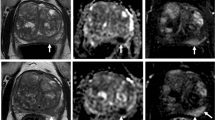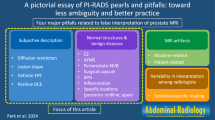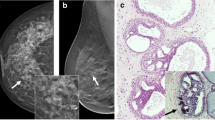Abstract
Purpose
To assess whether real-time elastography-targeted biopsy (RTE-bx) may help to correctly assign Gleason grade at radical prostatectomy (RP) and to compare discriminant properties of systematic biopsy alone (sbx) versus combination with RTE-bx (comb-bx) to distinguish between postoperatively favorable (Gleason 3 + 3, pT2, Nx/0) and postoperatively unfavorable (Gleason ≥4 + 4) prostate cancer (PCa) at RP.
Patients and methods
Overall, 259 patients diagnosed with PCa at systematic biopsy in combination with RTE-bx underwent RP between 2008 and 2011. Gleason Score derived from sbx versus comb-bx was compared to the gold-standard RP, and discriminant properties were assessed. Specificity gains were examined for sbx versus comb-bx when the endpoint consisted of postoperatively favorable PCa at RP. Sensitivity gains were examined, when analyses focused on postoperatively unfavorable PCa.
Results
Comb-bx resulted in higher correct overall Gleason assignment (68.3 vs. 56.7 %, p = 0.008) than sbx. Similarly, lower rates of undergrading (21.2 vs. 36.3 %, p < 0.001) were recorded. Specificity gains with comb-bx were 10 % (92 vs. 82 %, p = 0.004) for postoperatively favorable PCa. Comb-bx resulted in 31 % sensitivity gains relative to sbx (94 vs. 63 %, p = 0.03), when postoperatively unfavorable PCa was the endpoint.
Conclusion
The agreement between biopsy and pathology Gleason Score was significantly higher for comb-bx than sbx. Additionally, comb-bx reduced the rate of false positives in the diagnosis of favorable PCa. Rates of correctly classified unfavorable PCa at RP were also higher for comb-bx. Those data indicate that comb-bx is useful in clinical practice.

Similar content being viewed by others
References
Gleason DF, Mellinger GT, Veterans Administration Cooperative Urological Research G. (2002) Prediction of prognosis for prostatic adenocarcinoma by combined histological grading and clinical staging. J Urol 167(2 Pt 2):953–958 (discussion 959)
Salomon G, Drews N, Autier P et al (2014) Incremental detection rate of prostate cancer by real-time elastography targeted biopsies in combination with a conventional 10-core biopsy in 1024 consecutive patients. BJU Int 113(4):548–553
Heidenreich A, Bastian PJ, Bellmunt J et al (2014) EAU guidelines on prostate cancer. Part 1: screening, diagnosis, and local treatment with curative intent—update 2013. Eur Urol 65(1):124–137
Konig K, Scheipers U, Pesavento A, Lorenz A, Ermert H, Senge T (2005) Initial experiences with real-time elastography guided biopsies of the prostate. J Urol 174(1):115–117
Epstein JI, Lecksell K, Carter HB (1999) Prostate cancer sampled on sextant needle biopsy: significance of cancer on multiple cores from different areas of the prostate. Urology 54(2):291–294
Gleason DF, Mellinger GT (1974) Prediction of prognosis for prostatic adenocarcinoma by combined histological grading and clinical staging. J Urol 111(1):58–64
Budaus L, Isbarn H, Schlomm T et al (2009) Current technique of open intrafascial nerve-sparing retropubic prostatectomy. Eur Urol 56(2):317–324
Reiner WG, Walsh PC (1979) An anatomical approach to the surgical management of the dorsal vein and Santorini’s plexus during radical retropubic surgery. J Urol 121(2):198–200
Walsh PC (1998) Anatomic radical prostatectomy: evolution of the surgical technique. J Urol 160(6 Pt 2):2418–2424
McNeal JE, Redwine EA, Freiha FS, Stamey TA (1988) Zonal distribution of prostatic adenocarcinoma: correlation with histologic pattern and direction of spread. Am J Surg Pathol 12(12):897–906
Greene FL (2002) The American Joint Committee on Cancer: updating the strategies in cancer staging. Bull Am Coll Surg 87(7):13–15
Chun FK, Steuber T, Erbersdobler A et al (2006) Development and internal validation of a nomogram predicting the probability of prostate cancer Gleason sum upgrading between biopsy and radical prostatectomy pathology. Eur Urol 49(5):820–826
Salomon G, Kollerman J, Thederan I et al (2008) Evaluation of prostate cancer detection with ultrasound real-time elastography: a comparison with step section pathological analysis after radical prostatectomy. Eur Urol 54(6):1354–1362
Junker D, Schafer G, Aigner F et al (2012) Potentials and limitations of real-time elastography for prostate cancer detection: a whole-mount step section analysis. Sci World J 2012:193213
Pallwein L, Mitterberger M, Struve P et al (2007) Real-time elastography for detecting prostate cancer: preliminary experience. BJU Int 100(1):42–46
Hoeks CM, Hambrock T, Yakar D et al (2013) Transition zone prostate cancer: detection and localization with 3-T multiparametric MR imaging. Radiology 266(1):207–217
Donovan J, Hamdy F, Neal D et al (2003) Prostate testing for cancer and treatment (ProtecT) feasibility study. Health Technol Assess 7(14):1–88
Eichler K, Hempel S, Wilby J, Myers L, Bachmann LM, Kleijnen J (2006) Diagnostic value of systematic biopsy methods in the investigation of prostate cancer: a systematic review. J Urol 175(5):1605–1612
Author contributions
Boehm, Tennstedt, Salomon and Karakiewicz developed the protocol/project. Boehm, Beckmann, Schiffmann and Salomon contributed to data collection or management. Boehm, Tennstedt and Beyer analyzed the data. Boehm, Graefen, Michl, Beyersdorff, Budäus, Karakiewicz and Salomon contributed to manuscript writing/editing.
Author information
Authors and Affiliations
Corresponding author
Ethics declarations
Conflict of interest
We confirm that there are no competing financial interests in relation to the work described.
Disclosures
Nothing to disclose.
Ethical approval
The study was approved by the local ethics board, and all subjects provided written informed consent.
Rights and permissions
About this article
Cite this article
Boehm, K., Tennstedt, P., Beyer, B. et al. Additional elastography-targeted biopsy improves the agreement between biopsy Gleason grade and Gleason grade at radical prostatectomy. World J Urol 34, 805–810 (2016). https://doi.org/10.1007/s00345-015-1714-1
Received:
Accepted:
Published:
Issue Date:
DOI: https://doi.org/10.1007/s00345-015-1714-1




